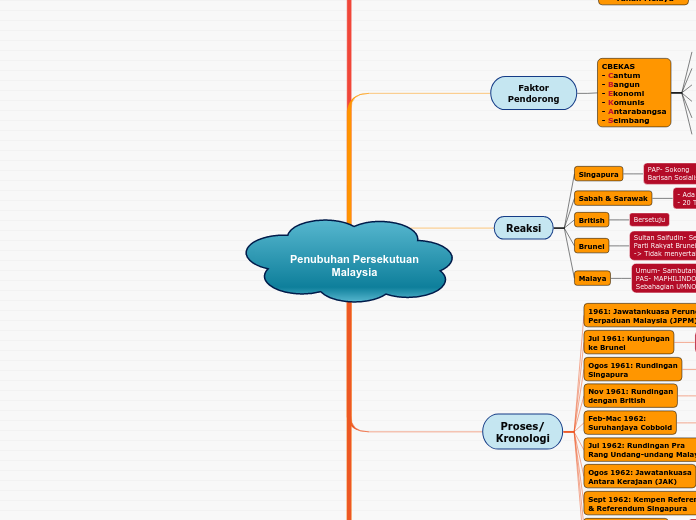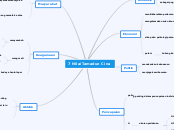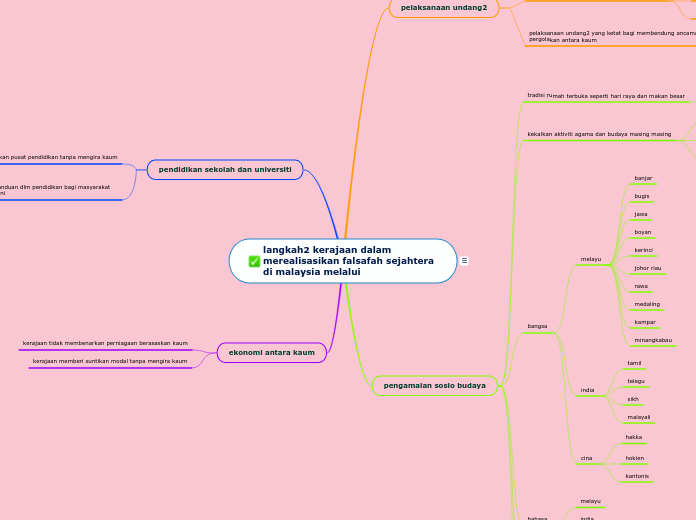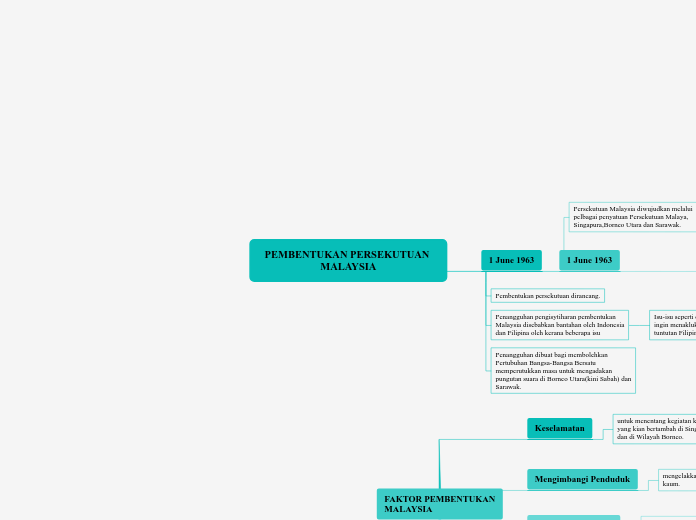Penubuhan Persekutuan
Malaysia
To name your story, you have to think about the overall message and what you want your audience to understand from the story. Also, make it relevant and easy to remember.
Cabaran
The ending of a story is essential. We all know that if the ending is weak, what happened before loses its importance. So make it unpredictable, but fair. A resolved ending answers all the questions and ties up any loose threads from the plot.
Singapura Keluar Malaysia
9 Ogos 1965
- Singapura rasmi keluar Malaysia
Sebab:
- Isu pilihan raya 1965
- idea 'Malaysian Malaysia'
- PAP vs Perikatan
Filipina
Tentangan Filipina
Sebab:
- isu milik waris Kesultanan Sulu
Indonesia
This is the closure section of the story.
See examples of possible outcomes below:
- all problems have been solved
- it's clear how each one of your characters ends up
- your main character is transformed by the challenge
Konfrontasi Indonesia
-Ganyang Malaysia
Try answering these questions in order for you to come up with a closure:
- Have all problems been solved?
- Is it clear what happens with all your characters in the story?
- Has the challenged transformed your main character?
- How do the characters feel in the end?
Sebab:
- Komunisme vs Neokolonialisme
- TAR vs Sukarno
- Indonesia kecil hati
This is the moment when the main character surpasses the last obstacle and finally faces their greatest challenge.
The climax usually follows one of these patterns:
- realization
- resolution
- choice
Type in your answer.
Brunei Tarik Diri
Sebab:
- kedudukan Sultan
-status negeri
- isu kewangan (minyak)
Aspek utama
Perlembagaan
- Agama persekutuan
- Bahasa persekutuan
- Kedudkan istimewa S&S
- Bidang kuasa istimewa S&S
- Kerusi di Dewan Rakyat Persekutuan
Proses/
Kronologi
The middle of the story is where you add layers of complications that will lead to the end. Reveal more about the character's journey. Did their personality go through changes? How did they overcome the challenges? And as you build up the story’s central conflict, make it more personal to that character. Also, from the middle act, you have to lead into the final act.
Julai 1963: Memeterai
Perjanjian Malaysia
Malaysia ditubuhkan 16 Sept 1963 ( Akta Malaysia)
Jun 1963: Misi BBB
- > 2/3 rakyat S&S sokong
Sept 1962: Kempen Referendum
& Referendum Singapura
- 70% bersetuju
Ogos 1962: Jawatankuasa
Antara Kerajaan (JAK)
- Tuntutan 20 Sabah
- Rangka Perlembagaan
Jul 1962: Rundingan Pra
Rang Undang-undang Malaysia
- Cadangan diselaras
Feb-Mac 1962:
Suruhanjaya Cobbold
- Pandangan rakyat S&S
- 80% setuju
Nov 1961: Rundingan
dengan British
- Pungutan suara
- Perjanjian pertahanan Eng-PTM
Ogos 1961: Rundingan
Singapura
There wouldn't be any tension and excitement in your story if there weren't any obstacles in your character's way.
- autonomi pendidikan & tenaga buruh
Jul 1961: Kunjungan
ke Brunei
Your character(s) need(s) motivation in order to solve the challenge(s).
- Penjelasan
- Sultan-> suruhanjaya
Secondary characters also might have motivs beacuse of which they may cross path with main character or which might trigger them to help the main character.
1961: Jawatankuasa Perundingan
Perpaduan Malaysia (JPPM)
Each story has a main character and that character usually needs to solve a problem or challenge. The character's challenge is the one that creates tension throughout the story.
- Penjelasan konsep Malaysia; Lawatan Muhibbah
- Perelmbagaan PTM 1957
Reaksi
Malaya
Umum- Sambutan baik
PAS- MAPHILINDO
Sebahagian UMNO- Kurang yakin
Brunei
Sultan Saifudin- Setuju
Parti Rakyat Brunei- Tentang
-> Tidak menyertai
British
Bersetuju
Sabah & Sarawak
- Ada yang bersetuju dan tidak
- 20 Tuntutan Sabah
Singapura
PAP- Sokong
Barisan Sosialis- Tentang
Faktor
Pendorong
CBEKAS
- Cantum
- Bangun
- Ekonomi
- Komunis
- Antarabangsa
- Seimbang
KeSeimbangan kaum dan perpaduan
Bersatu dalam hubungan Antarabangsa
Bersama membanteras Komunis
Mewujudkan kerjasama Ekonomi
Persefahaman untuk pemBangunan
Kemerdekaan melalui perCantuman
Latar Belakang
In the beginning of the story (or the exposition), you will need to introduce the setting and characters. You might also want to introduce the main conflict. This part of the story is important because it gives the reader necessary background information and maybe even a first insight into a character’s personality.
Cadangan daripada
Tanah Melayu
The setting (time & place) of a story can change throughout the plot.
1962 TAR
- Gabung semua
1955 TAR
- TM-Singapura
Sensory details include sight, sound, touch, smell, and taste. These details are important because they create depth in your setting.
See a few examples below:
- the smell of fresh bread
- the scent of freshly cut grass
- rain falling onto the windshield etc.
Status Politik
Negeri
Tanah Melayu- Merdeka
Singapura & Brunei- Naungan British
Sabah & Sarawak- Jajahan British
Ingin digabung dengan matlamat-
MERDEKA!
Idea Penyatuan Negeri
(T.Melayu, Singapura, Brunei,
Sabah dan Sarawak)
Characters are essential to a good story. Usually, the protagonist(s) is/are the most affected by the plot. Introduce a character by focusing on their actions, interests, and occupation, as the physical appearance doesn't make a difference in most cases.
Tempatan
1954 Ghazali Shafie
1955 Tan Chen Lock, TAR
1959 Lee Kuan Yew
1948 Thio Chan Bee
- Gabung semua
Which traits best describe the character's personality? Choose more if necessary:
introvertedloyalkindindependentquick-thinkingadventuresomeidealisticsweet-naturedcalmrisk-takercreativewittystrictfussyweirdclumsyharshaggressivecarelessclingingcowardlycrueldeceitfulimpulsiveOther
1955 David Marshall
- Gabung Singapura-Malaya
Inggeris
Type in the name of your character.
Malcolm McDonald
- Ditentang
Add other properties of the character.
1888, 1932 Kabinet British
- Bincang
What is your character's main goal?
fight Evilfind lovedefeat his/her enemyrule the worldmake friendstime travelmake an awesome discoveryOther
1883 Lord Brassey
- Gabung TM-Borneo British
Choose the type of your chacter:
Protagonist (main character)Antagonist (main character's opponent)Flat (stereotypical character)Round (his/ her personality develops throughout the story)Static (doesn't evolve as a person throughout the story)Dynamic (dramatical change in personality)Confidant (the main character trusts him/ her)Foil (contrasting character who enhances the personality of another character)Other










